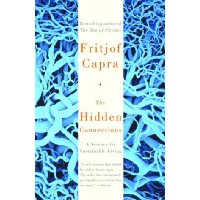| 商家名称 |
信用等级 |
购买信息 |
订购本书 |
|
|
 |
The Hidden Connections: A Science for Sustainable Living |
 |
|
 |
The Hidden Connections: A Science for Sustainable Living |
 |

基本信息·出版社:Anchor
·页码:320 页
·出版日期:2004年01月
·ISBN:0385494726
·International Standard Book Number:0385494726
·条形码:9780385494724
·EAN:9780385494724
·装帧:平装
·正文语种:英语
内容简介 Fritjof Capra, bestselling author of
The Tao of Physics and
The Web of Life, here explores another frontier in the human significance of scientific ideas—applying complexity theory to large-scale social interaction.
In the 1980s, complexity theory emerged as a powerful alternative to classic, linear thought. A forerunner of that revolution, Fritjof Capra now continues to expand the scope of that theory by establishing a framework in which we can understand and solve some of the most important issues of our time. Capra posits that in order to sustain life, the principles underlying our social institutions must be consistent with the broader organization of nature. Discussing pertinent contemporary issues ranging from the controversial practices of the World Trade Organization (WTO) to the Human Genome Project, he concludes with an authoritative, often provocative plan for designing ecologically sustainable communities and technologies as alternatives to the current economic globalization.
作者简介 Fritjof Capra, a world-renowned physicist, is the author of
The Tao of Physics, The Turning Point, Uncommon Wisdom, The Web of Life, and the coauthor of
Belonging to the Universe, winner of the American Book Award in 1992. He is a founding director of the Center for Ecoliteracy in Berkeley, California, where he lives. For more information, please go to
www.fritjofcapra.net 媒体推荐 ?A rich resource that should be widely drawn upon. . . . The author has courageously put together a real tract for our times.? ?
Nature
"A cool and rational analysis . . . for those feeling a bit confused or helpless in the face of an upredictable future. . . . A book that could make a difference." ?
The Guardian?Capra has forged and interesting book, which challenges conventional wisdom, provides insights into social and economic pitfalls and offers some light at the end of the tunnel.? ?
The Sunday Times (London)
?
The Hidden Connections transcends intellectual barriers, overflows with groundbreaking ideas, and combines scholarly science with spirituality. It is a work of rare genius, true insight and great humanity.? ?
Waterstone?s Books Quarterly
--
Review 文摘 One
THE NATURE OF LIFE
Before introducing the new unified framework for the understanding of biological and social phenomena, I would like to revisit the age-old question "What is life?" and look at it with fresh eyes. I should emphasize right from the start that I will not address this question in its full human depth, but will approach it from a strictly scientific perspective; and even then, my focus will at first be narrowed down to life as a biological phenomenon. Within this restricted framework, the question may be rephrased as: "What are the defining characteristics of living systems?"
Social scientists might prefer to proceed in the opposite order--first identifying the defining characteristics of social reality, and then extending into the biological domain and integrating it with corresponding concepts in the natural sciences. This would no doubt be possible, but having been trained in the natural sciences and having previously developed a synthesis of the new conception of life in these disciplines, it is natural for me to begin there.
I could also argue that, after all, social reality evolved out of the biological world between two and four million years ago, when a species of "Southern apes" (
Australopithecus afarensis) stood up and began to walk on two legs. At that time, the early hominids developed complex brains, toolmaking skills and language, while the helplessness of their prematurely born infants led to the formation of the supportive families and communities that became the foundation of human social life. Hence, it makes sense to ground the understanding of social phenomena in a unified conception of the evolution of life and consciousness.
Focus on Cells
When we look at the enormous variety of living organisms--animals, plants, people, microorganisms--we immediately make an important discovery: all biological life consists of cells. Without cells, there is no life on this Earth. This may not
……




